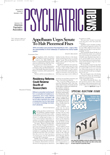All aggression is not alike, according to experts who have studied aggressive behaviors in primates and humans. Those who become aggressive on the spur of the moment differ physiologically from those who plan aggressive acts ahead of time.
The biological characteristics of aggression and implications for treatment were discussed by a panel of experts at the October annual meeting of the American Academy of Psychiatry and the Law (AAPL) in San Antonio.
“One of the most consistent findings in biological psychiatry is the association between low serotonin function and impulsivity and impulsive aggression,” said F. Gerard Moeller, M.D., an associate professor of psychiatry and behavioral sciences at the University of Texas Medical School at Houston.
Mice become more aggressive with reduced serotonin function, he said, and in primates reduced serotonin levels lead to “severe, unrestrained aggression,” which has then been associated with shorter life-spans.
In his own research, Moeller has linked reduced levels of 5-hydroxindole acetic acid, a serotonin metabolite, with increased aggression in humans. Other researchers have associated low serotonin levels with violent suicide attempts, impulsive aggression, and impulsive arson, he said.
Yet not all people with impulsive aggression have lower-than-usual serotonin levels, he cautioned.
One part of the brain that may play an important role in mediating impulsive aggression, according to Moeller, is the prefrontal cortex.
He cited research by Antoine Bechara, Ph.D., who found that people with lesions on the ventromedial areas of their prefrontal cortex were more likely than normal controls to delay gratification. Others, like Jordan Grafman, Ph.D., have found that people with the lesions are more aggressive than their normal counterparts, Moeller said.
He also recalled the case of Phineas Gage, a hard-working railroad construction worker who became irritable and profane following a serious injury to his prefrontal cortex in the mid-1800s.
Moeller said that a few studies have found selective serotonin reuptake inhibitors to be effective in reducing levels of impulsive aggression in people. Emily Cocarro, M.D., for instance, found in 1997 that fluoxetine reduced aggression in a sample of people with borderline personality disorder.
According to AAPL panel member Matthew Stanford, Ph.D., who is a professor in Baylor University’s department of psychology and neuroscience, there are fundamental differences between impulsively aggressive people and those whom he called “premeditative aggressors,” or people who plan the majority of their aggressive acts.
Premeditative aggressors “control their aggression very well,” Stanford noted. “They use it to get what they want.”
Impulsive aggressors lack the ability to control their aggression and have described themselves to Stanford as “Jekyll and Hyde. . . . They feel as if they are two different people,” he said.
Stanford described both groups as “very angry and hostile,” but said impulsive aggressors appear to have impaired executive functioning. On neuropsychiatric testing, for example, impulsive aggressors have performed poorly on verbal fluency and design-oriented tasks. “They have trouble strategizing and planning,” he observed, which are prefrontal cortical functions.
Stanford has found that premeditative aggressors, however, typically perform normally on these tasks.
Although psychological tests reveal a great deal of personality pathology in the premeditative-aggressor group, Stanford remarked, “they have normal cognitive functioning.”
When Stanford and his colleagues tested the effects of phenytoin on 60 prison inmates who were either impulsive or premeditative aggressors, he found that the anticonvulsant reduced the frequency and intensity of impulsive aggressive acts but not premeditated aggressive acts. The article appeared in the October 1997 Journal of Clinical Psychopharmacology.
“Not only are there physiological differences between the two groups, but also the two groups respond differently to treatments,” he emphasized. ▪

